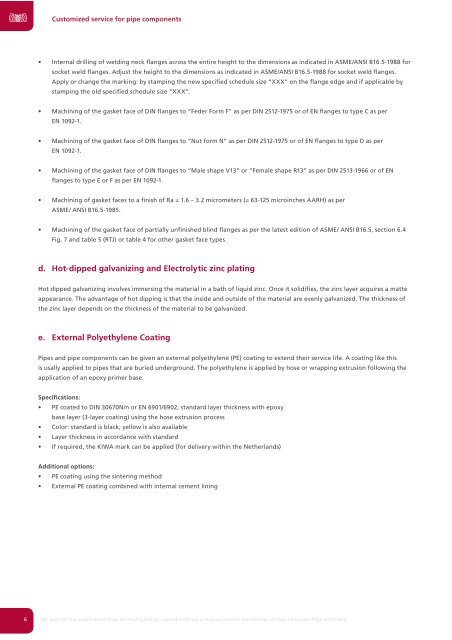Pipe Components 2011 - Van Leeuwen Buizen
Pipe Components 2011 - Van Leeuwen Buizen
Pipe Components 2011 - Van Leeuwen Buizen
You also want an ePaper? Increase the reach of your titles
YUMPU automatically turns print PDFs into web optimized ePapers that Google loves.
Customized service for pipe components<br />
• Internal drilling of welding neck flanges across the entire height to the dimensions as indicated in ASME/ANSI B16.5-1988 for<br />
socket weld flanges. Adjust the height to the dimensions as indicated in ASME/ANSI B16.5-1988 for socket weld flanges.<br />
Apply or change the marking: by stamping the new specified schedule size “XXX” on the flange edge and if applicable by<br />
stamping the old specified schedule size “XXX”.<br />
• Machining of the gasket face of DIN flanges to “Feder Form F” as per DIN 2512-1975 or of EN flanges to type C as per<br />
EN 1092-1.<br />
• Machining of the gasket face of DIN flanges to “Nut form N” as per DIN 2512-1975 or of EN flanges to type D as per<br />
EN 1092-1.<br />
• Machining of the gasket face of DIN flanges to “Male shape V13” or “Female shape R13” as per DIN 2513-1966 or of EN<br />
flanges to type E or F as per EN 1092-1.<br />
• Machining of gasket faces to a finish of Ra = 1.6 – 3.2 micrometers (= 63-125 microinches AARH) as per<br />
ASME/ ANSI B16.5-1985.<br />
• Machining of the gasket face of partially unfinished blind flanges as per the latest edition of ASME/ ANSI B16.5, section 6.4<br />
Fig. 7 and table 5 (RTJ) or table 4 for other gasket face types.<br />
d. Hot-dipped galvanizing and Electrolytic zinc plating<br />
Hot dipped galvanizing involves immersing the material in a bath of liquid zinc. Once it solidifies, the zinc layer acquires a matte<br />
appearance. The advantage of hot dipping is that the inside and outside of the material are evenly galvanized. The thickness of<br />
the zinc layer depends on the thickness of the material to be galvanized.<br />
e. External Polyethylene Coating<br />
<strong>Pipe</strong>s and pipe components can be given an external polyethylene (PE) coating to extend their service life. A coating like this<br />
is usally applied to pipes that are buried underground. The polyethylene is applied by hose or wrapping extrusion following the<br />
application of an epoxy primer base.<br />
Specifications:<br />
• PE coated to DIN 30670N/n or EN 6901/6902, standard layer thickness with epoxy<br />
base layer (3-layer coating) using the hose extrusion process<br />
• Color: standard is black; yellow is also available<br />
• Layer thickness in accordance with standard<br />
• If required, the KIWA mark can be applied (for delivery within the Netherlands)<br />
Additional options:<br />
• PE coating using the sintering method<br />
• External PE coating combined with internal cement lining<br />
6 No part of this publication may be multiplied or copied without previous written permission of <strong>Van</strong> <strong>Leeuwen</strong> <strong>Pipe</strong> and Tube


